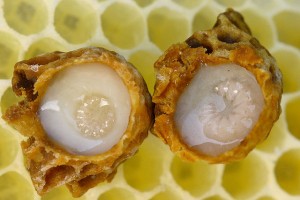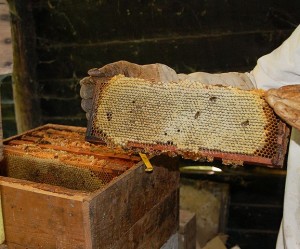Sweet Event
On a warm summer evening a group of people gathered together to experience the taste of sweetness through a honey tasting prepared by underground chef and wild forager, Alexander McNaughton.
While the taste of sweet can be found in many foods, I decided to focus on honey as the main vehicle for this intoxicating sensation, because it can be sourced locally and comes from this unique relationship between humans, insects and plants. In order to convey the importance of these relations, I invited Randy Lee Cutler, a Vancouver writer, artist and educator to talk about the many ways we are indebted to the honey bee.
Based on her research in preparation for an ebook focussed on bees, Randy took us through the anatomy of the bee explaining how each body part produces something we, as humans, consume. She began with the head of the worker bee which contains the hypopharynx gland. This gland produces royal jelly; a secretion that is used to feed larvae. The royal aspect comes into play when the workers begin to feed some larvae copious amounts of the secretion in order to nurture a new queen bee. The excessive amount of jelly makes it possible for the larvae to develop sexually so she can lay eggs; a critical function for the queen of the hive.
As Randy discussed each part of the bee, it became apparent that honey was only a small part of what we appreciate from bees. They also produce wax, pollen, and propolis; a resinous mixture from tree sap which is appreciated for it’s antimicrobial properties.
After Randy’s talk, Alexander served a spiced mead produced on Vancouver Island and we gave a toast to the bees that produced the feast we were about to enjoy. While people sipped their mead, I shared a traditional mead recipe published in a 1699 cookbook compiled from the notes of Sir Kenelm Digby, called the “Closet of Sir Kenelm Digby, Knight, Opened.”
Take 18 quarts of spring-water, and one quart of honey; when the water is warm, put the honey into it. When it boileth up, skim it very well, and continue skimming it, as long as any scum will rise. Then put in one Race of Ginger (sliced in thin slices), four Cloves, and a little sprig of green Rosemary. Let these boil in the Liquor so long, till in all it have boiled one hour. Then set it to cool, till it be blood-warm, and then put it to a spoonful of Ale-yeast. When it is worked up, put it into a vessel of a fit size; and after two or three days, bottle it up. You may drink it after six weeks, or two months. (A Short History of the Honey Bee, p. 146)
The second tasting was a cardamom infused honey drizzled on bread spread with a local cultured butter. This combination of savoury and sweet was warm and comforting. A nice transition from the spiced mead.
While people ate, I shared some thoughts on sweetness from writer Adam Gopnik. In his book “The Table Comes First” he ponders the question “How Does Taste Happen?”. In this book he carries on a feigned conversation with nineteenth century food critic Elizabeth Pennell, who authored a book called “The Delights of Delicate Eating”. Through this conversation he grapples with her articulation of food and taste and what that might reveal about our contemporary attitude and approach to food.
Gopnik addresses the nineteenth century banishment of strong spice in favor of natural more subtle flavours. Spice was regarded as a kind of concealment, a dishonest mask while sweetness was seen as childish or immature.
“Kids like sweet tastes. To banish sweet and strong spices was to end the childhood of cooking.”
It was also a matter of taste in the other sense of the word. Pennell along with others of her time made it a distinction of class and status to prefer “refined” tastes as determined by them.
The third tasting brought together a bee balm infused honey with a side greens.
“Infants that are fed salt, sweet, sour and bitter tastes react visibly with disgust to the last two flavours but show pleasure when they encounter a sweet taste. In this they resemble fruit-eating monkeys, who associate sweetness with the presence of sugars (whose molecules have a high energy value) and bitter with vegetables that contain toxic alkaloids. Gradually children learn through conditioning and culture to diversify their diet.” (Herve This, Molecular Gastronomy, p. 120)
The fourth tasting brought together fresh apricots and cherries, with a local blue cheese and honey comb.
Sweetness is often associated with the base, primal or Bacchanalian. Pursuit of this pleasure is seen as hedonistic, placing humans in relation with other animals that seeks high caloric value from the sticky, perfumed affair of plant reproduction. The taste of sweetness is intoxicating which means to stupefy or excite by the action of a chemical substance.
Journalist Michael Pollan discusses the historical use of the term sweet in his book the “Botany of Desire.” When the experience of sweetness was an experience more rare and special it served as a metaphor for perfection. “Like a shimmering equal sign, the word sweetness denoted a reality commensurate with human desire: it stood for fulfillment.” (Pollan, p. 17) By the nineteenth century sweetness became associated with the saccharine and sentimental. Pollan speculates this might be due to the advent of cheap cane sugar made available through colonial power and slavery.
By the fifth tasting, I felt like my blood was singing with sugar. This was perhaps a good time for Alexander to balance out some of the sweetness with some sourness. He combined greek yogurt, lemon infused honey and blueberries together.
As chef Sybil Kappor suggests in her cookbook “Taste: A New Way to Cook”
“Our taste buds translate the various types of sugar, such as fructose, glucose, and lactose, and unrelated chemicals such as chloroform, saccharin and aspartame as sweetness. Thus, honey, peas and cream all contain varying degrees of sweetness. Like salt, the more sweetness we consume the less of it we can taste. Most food has a dominant taste. If you have a sweet taste and you season it with a few drops of sourness it will seem even sweeter. But the more sourness you add, the less sweet it will become until it tastes sour.” (p.10)
And finally dessert, if there is such as thing in the context of a honey tasting. Alexander served a small dish of local ice cream, raspberries and vanilla infused honey.
This may seem decadent until one considers a Baroque banquet like the one held in the year 1668 in honor of Queen Christina of Sweden in Caste de Novo, Italy.
“At Baroque banquets sugar usually played the leading role. The culinary arts of Muslim courts inspired the Western art of the table, where sweet and scented ingredients were the most esteemed. In Medieval Europe sugar had previously been used only for medicinal purposes, but it soon became a central part of every important banquet. Sweetness was the dominant flavour – whether it was sugared oysters and lettuce cores, or peacock terrines and ham.” (Charlotte Birnbaum, Three Banquets for a Queen, p. 13)
The menu for the third course:
Sweets and Candies
Smooth sugar-coated almonds
Melon seeds
Sugar-coated cloves
Round musked dragees
Sugar-coated chocolate
Sugar-coated aniseed served on a napkin
Glasses filled with quince jelly as above
Candied fruits
Genoa plums
Peaches
Marmalade
Pieces of peach jelly
Candied citrons
Lettuce cores
(Charlotte Birnbaum, Three Banquets for a Queen, p. 81)







Leave a Reply